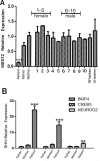MED12-Related Disease in a Chinese Girl: Clinical Characteristics and Underlying Mechanism
- PMID: 32174975
- PMCID: PMC7056888
- DOI: 10.3389/fgene.2020.00129
MED12-Related Disease in a Chinese Girl: Clinical Characteristics and Underlying Mechanism
Abstract
The RNA polymerase II transcription subunit 12 homolog (MED12) is a member of the mediator complex, which plays a critical role in RNA transcription. Mutations in MED12 cause X-linked intellectual disability and other anomalies collectively grouped as MED12-related disorders. While MED12 mutations have been most commonly reported in male patients, we present the case of a 1-year-old girl with clinical characteristics similar to MED12-related disorders. To explore the clinical characteristics of the condition and its possible pathogenesis, we analyzed the patient's clinical data; genetic testing by whole-exome sequencing revealed a de novo heterozygous mutation (c.1249-1G > C) in MED12. Further cDNA experiments revealed that the patient had an abnormal splicing at the skipping of exon9, which may have produced a truncated protein. qPCR showed decreased MED12 gene expression level in the patient, and an X-chromosome inactivation test confirmed a skewed inactivation of the X-chromosome. The lymphoblast transcription levels of the genes involved in the Gli3-dependent sonic hedgehog (SHH) signaling pathway, namely, CREB5, BMP4, and NEUROG2, were found to be significantly elevated compared with those of her parents and sex- and age-matched controls. Our results support the view that MED12 mutations may dysregulate the SHH signaling pathway, which may have accounted for the aberrant craniofacial morphology of our patient.
Keywords: MED12; SHH signaling pathway; X-chromosome inactivation; craniofacial morphology; intellectual disability; mutation.
Copyright © 2020 Wang, Lin, Xue, Wang, Liu, Ou, Wu, Lan, Zhang, Yuan, Luo, Wang, Xi, Sun and Chen.
Figures



Similar articles
-
Dysregulations of sonic hedgehog signaling in MED12-related X-linked intellectual disability disorders.Mol Genet Genomic Med. 2019 Apr;7(4):e00569. doi: 10.1002/mgg3.569. Epub 2019 Feb 6. Mol Genet Genomic Med. 2019. PMID: 30729724 Free PMC article.
-
MED12 mutations link intellectual disability syndromes with dysregulated GLI3-dependent Sonic Hedgehog signaling.Proc Natl Acad Sci U S A. 2012 Nov 27;109(48):19763-8. doi: 10.1073/pnas.1121120109. Epub 2012 Oct 22. Proc Natl Acad Sci U S A. 2012. PMID: 23091001 Free PMC article.
-
Mediator modulates Gli3-dependent Sonic hedgehog signaling.Mol Cell Biol. 2006 Dec;26(23):8667-82. doi: 10.1128/MCB.00443-06. Epub 2006 Sep 25. Mol Cell Biol. 2006. PMID: 17000779 Free PMC article.
-
MED12 related disorders.Am J Med Genet A. 2013 Nov;161A(11):2734-40. doi: 10.1002/ajmg.a.36183. Epub 2013 Oct 10. Am J Med Genet A. 2013. PMID: 24123922 Free PMC article. Review.
-
Insights into the regulatory role and clinical relevance of mediator subunit, MED12, in human diseases.J Cell Physiol. 2021 May;236(5):3163-3177. doi: 10.1002/jcp.30099. Epub 2020 Nov 10. J Cell Physiol. 2021. PMID: 33174211 Review.
Cited by
-
A novel nonsense variant in MED12 associated with malformations in a female fetus.Clin Case Rep. 2021 Dec 22;9(12):e05124. doi: 10.1002/ccr3.5124. eCollection 2021 Dec. Clin Case Rep. 2021. PMID: 34987808 Free PMC article.
-
Macrocephaly and Finger Changes: A Narrative Review.Int J Mol Sci. 2024 May 20;25(10):5567. doi: 10.3390/ijms25105567. Int J Mol Sci. 2024. PMID: 38791606 Free PMC article. Review.
-
MED12-related Hardikar syndrome: Two additional cases and novel phenotypic features.Am J Med Genet A. 2022 Jul;188(7):2231-2236. doi: 10.1002/ajmg.a.62756. Epub 2022 Apr 6. Am J Med Genet A. 2022. PMID: 35385210 Free PMC article.
-
Two heterozygous mutations in the calcium/calmodulin-dependent serine protein kinase gene (CASK) in cases with developmental disorders.Mol Genet Genomic Med. 2022 Nov;10(11):e2065. doi: 10.1002/mgg3.2065. Epub 2022 Sep 28. Mol Genet Genomic Med. 2022. PMID: 36168867 Free PMC article.
References
-
- Clark R. D., Graham J. M., Jr., Friez M. J., Hoo J. J., Jones K. L., McKeown C., et al. (2009). FG syndrome, an X-linked multiple congenital anomaly syndrome: the clinical phenotype and an algorithm for diagnostic testing. Genet. Med. 11 (11), 769–775. 10.1097/GIM.0b013e3181bd3d90 - DOI - PMC - PubMed
LinkOut - more resources
Full Text Sources

